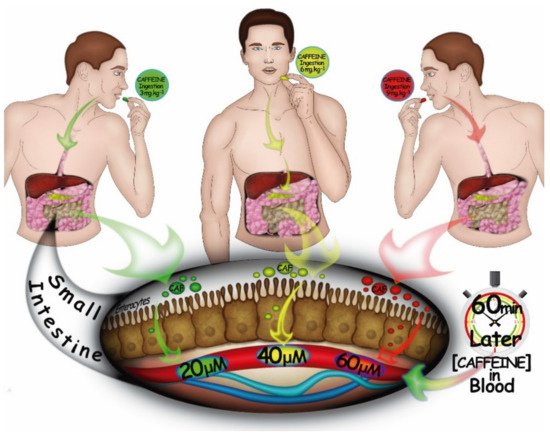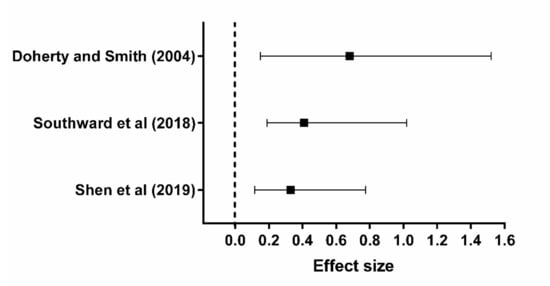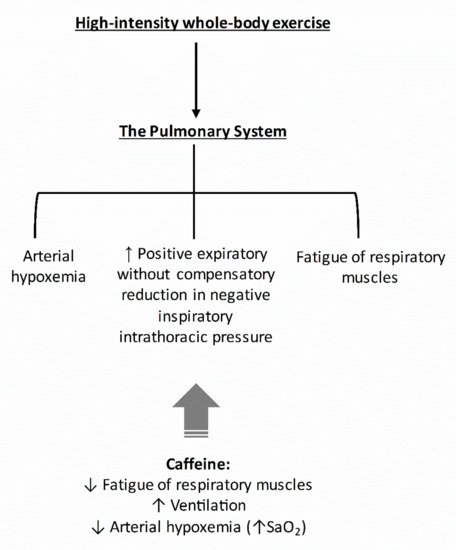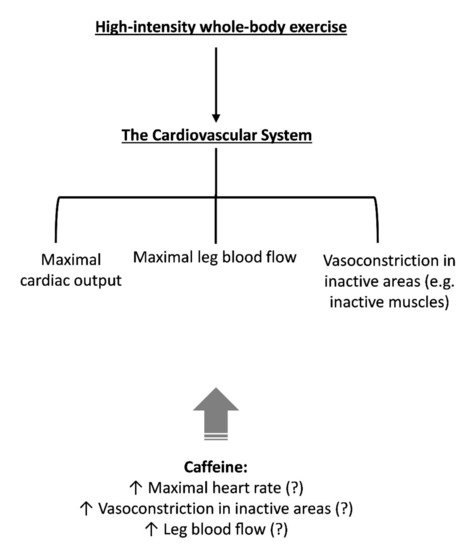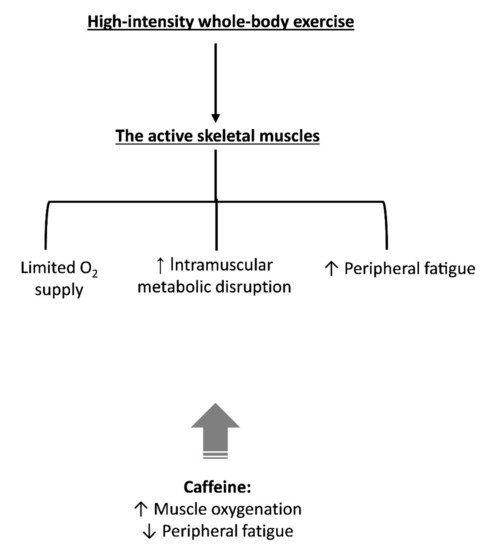Caffeine (1,3,7-trimethylxanthine) is an alkaloid widely used to improve exercise performance
[1][2]. Following doses of 3 to 9 mg kg
−1 of body mass, caffeine is completely absorbed by the gastrointestinal tract and peaks in the plasma (20 to 60 µM, in a dose-dependent manner) within approximately 1 h after ingestion
[3][4] (
Figure 1). Caffeine can pass through all biological membranes and is readily distributed throughout all tissues of the body
[5]. Its subsequent ergogenic effects have been demonstrated for many types of exercise, such as those involving muscle endurance, muscle strength, anaerobic power, and aerobic endurance
[6][7][8]. Regarding aerobic endurance, caffeine seems to improve performance in both closed-loop exercises, in which work rate can be continually regulated in an attempt to complete the task as quickly as possible, and in open-loop exercise, in which work rate is fixed and exercise is performed to the limit of exhaustion
[9][10][11][12] (
Figure 2).
An important characteristic of aerobic endurance is that it typically requires the recruitment of a large muscle mass. Thus, “whole-body exercise” (e.g., cycling and running) is of special interest because of its functional relevance and significant engagement and interaction of various physiological systems
[13]. The second characteristic of aerobic endurance is that exercise encompasses a large range of exercise durations (from 75 seconds to hours, see Gastin
[14]). Furthermore, the stress imposed on various physiological systems during whole-body endurance exercise will increase as a function of exercise intensity. Specifically, endurance exercise performed above critical power or 85 to 90% of maximal oxygen uptake (V ̇O2max), which can be defined as “severe-intensity exercise” or “high-intensity exercise”, is associated with progressive derangements of homeostasis and rapid achievement of (V ̇O2max), with subsequent attainment of task failure
[15]. It is noteworthy that caffeine retains its ergogenic effects even in endurance exercise with such characteristics
[16].
Caffeine-induced improvements in endurance performance are commonly associated with mechanisms residing within the central nervous system, via its inhibitory action on A
1 and A
2a adenosine receptors
[3]. However, the abundance of adenosine A
1 and A
2a receptors in other non-nervous tissues (e.g., heart, blood vessels, lungs, and skeletal muscle
[17][18]), and the special characteristic of high-intensity whole-body exercise, in which several physiological systems are stressed to their limit of tolerance, suggest it is important to assess the potential effects of caffeine on other physiological systems during this mode of exercise
[19]. An understanding of the effects of caffeine on multiple physiological systems during whole-body, high-intensity exercise might help expand its use in different sporting contexts or even for the treatment of some diseases. For example, a potential effect of caffeine influencing the pulmonary system and maintaining arterial O
2 saturation (S
aO
2) might be helpful for athletes competing in hypoxic environments at high altitude or for patients with chronic obstructive pulmonary disease engaging in an exercise training program
[20][21].
2. The Pulmonary System
The primary objective of the pulmonary system during exercise is to maintain the partial pressures of oxygen and carbon dioxide in the blood (PO
2 and PCO
2, respectively) as close as possible to resting values
[13][22]. To meet this requirement, respiratory muscle work and alveolar ventilation increase considerably during high-intensity whole-body exercise
[23]. The capacity of the pulmonary system is generally assumed as sufficient to match the demands imposed by endurance exercise
[22]. However, there is research indicating that the pulmonary demands associated with high-intensity whole-body exercise may outstrip the functional capacity of the respiratory system and eventually compromise arterial O
2 content
[13][22][23]. In general, the three main limitations associated with the pulmonary system response to high-intensity whole-body exercise are: (1) exercise-induced arterial hypoxemia, (2) respiratory muscle fatigue, and (3) expiratory positive pressure effects on cardiac output.
Exercise-induced arterial hypoxemia refers to a reduction in S
aO
2 greater than 5% from resting levels (S
aO
2 is ~98% at rest)
[22]. Although some studies suggest a similar phenomenon during less intense exercise
[24][25], exercise-induced arterial hypoxemia is commonly reported during sustained high-intensity whole-body exercise and may compromise exercise tolerance
[24][25][26]. A detailed discussion about the main mechanisms governing exercise-induced arterial hypoxemia is beyond the scope of this review and readers are directed to other works
[21][23][27]. In brief, exercise-induced arterial hypoxemia has been attributed to multiple mechanisms such as inadequate compensatory hyperventilation, excessive widening of the alveolar to arterial O
2 difference, and a rightward shift of the oxyhemoglobin dissociation curve (acid- and temperature-induced). Regardless of the mechanisms, exercise-induced arterial hypoxemia might compromise O
2 transport to active muscles
[28][29].
Fatigue of the respiratory muscles can also compromise O
2 transport to active muscles. Accumulation of metabolites associated with fatiguing contractions of the inspiratory and expiratory muscles activate metabosensitive phrenic nerves, which may reflexively increase sympathetic vasoconstriction of the vasculature in locomotor muscles and ultimately reduce muscle perfusion and O
2 delivery in an attempt to preserve/increase blood flow to the respiratory muscles
[28][30]. In addition, increases in positive expiratory intrathoracic pressure, not sufficiently counterbalanced by a reduction in negative inspiratory intrathoracic pressure, will increase the ventricular afterload and thereby decrease stroke volume during high-intensity whole-body exercise
[22]. Such alterations might reduce the blood flow to the locomotor muscles, reducing O
2 supply to the active muscles.
A question arising from the above is whether caffeine ingestion can attenuate the imposed respiratory system limitations during high-intensity whole-body exercise. There is some research suggesting that caffeine influences ventilation ( E), end-tidal O2 partial pressure (PETO2), and SaO2 during progressive treadmill exercise to exhaustion in athletes with moderate-to-severe exercise-induced hypoxemia [20]. Specifically, caffeine increased PETO2 and SaO2 during the highest workloads (75 to 90% of O2max), which was associated with an increased E. Interestingly, caffeine increased E at 100% of O2max but this was not enough to counteract the reduction in SaO2 with the increase in workload [31]. It was suggested that a large portion of the increased E with caffeine at this exercise intensity may have reached dead space ventilation rather than alveolar ventilation.
The mechanisms by which caffeine increases E and prevents arterial O2 desaturation during high-intensity whole-body exercise are not fully known. Studies in resting animals [32] and humans [33] suggest a centrally-mediated effect of caffeine, where caffeine may directly act on the respiratory center and increase its sensitivity to carbon dioxide. Equivocal results, however, have been reported about the action of caffeine on peripheral chemoreceptors. While caffeine seems to increase the resting ventilatory response to progressive isocapnic hypoxia and hyperoxic hypercapnia in healthy men [34], a study with well-trained athletes failed to find such effects [31]. Whether such central and/or peripheral effects of caffeine are preserved during high-intensity whole-body exercise is difficult to experimentally assess. Caffeine also promotes relaxation of smooth muscles of the bronchi, inducing bronchodilatation and protecting from bronchoconstriction induced by a bronchoprovocation challenge with dry gas or exercise [35,36]. As near-maximal bronchodilatation probably already occurs during high-intensity whole-body exercise [37,38], it is not known whether this caffeine-induced bronchodilation effect will remain important in such conditions. Finally, caffeine augments the contractility and endurance of the inspiratory muscles, while concomitantly reducing the sense of effort associated with fatiguing inspiratory muscle contractions, probably by overcoming a fatigue-induced reduction in the outflow from the central respiratory motoneuron pool and/or altering respiratory motor neuron firing patterns [39].
As the pulmonary system imposes considerable limitations during high-intensity whole-body exercise, the caffeine-induced increases in E and the preservation of near resting SaO2 may account for part of the ergogenic effects of caffeine in this mode of exercise. In Figure 3, we provided a hypothetical construct by which caffeine might affect the pulmonary system.
Figure 3. Main physiological events within the pulmonary system that might contribute to fatigue during high-intensity whole-body exercise. The potential influence of caffeine on components of the pulmonary system that might explain part of its ergogenic effect is also indicated. Caffeine reduces fatigue of respiratory muscles
[39] and increases pulmonary ventilation and arterial oxygen saturation
[20][31].
3. The Cardiovascular System
The cardiovascular system provides the link between pulmonary ventilation and oxygen usage at the cellular level. During high-intensity whole-body exercise, heart rate and stroke volume (and consequently cardiac output, Q ̇) increase progressively until reaching maximal values [40]. Leg blood flow (Q ̇L) will also be close to maximal and might limit both muscle O2 delivery and endurance exercise performance [28]. As written earlier, although controversial [41], Q ̇L during high-intensity whole-body exercise may be reflexively reduced via vasoconstriction of the vasculature of the exercising limb due to the increased O2 demand by the respiratory musculature [28]. In addition, a substantial augmentation of expiratory positive pressures during strenuous exercise may decrease stroke volume, further exacerbating the limitation of Q ̇L [42].
Data related to the effects of caffeine ingestion on stroke volume, Q ̇, and Q ̇L during high-intensity whole-body exercise are limited. To our knowledge, only one study has investigated this question and found no increase in stroke volume or Q ̇ during an incremental, symptom-limited, maximal supine bicycle exercise after caffeine ingestion [43]. There are more data regarding the effects of caffeine on maximal heart rate, but results are contradictory with some studies showing increased maximal heart rate [44][45] and others not [46][47][48]. However, most studies showing no effect of caffeine on maximal heart rate were conducted using multiple, 60-s, maximal cycling bouts [46][47], which may not have allowed sufficient time to reach maximal heart rate. Studies showing a positive effect of caffeine on maximal heart rate were performed using a maximal incremental test [44][45]. Indeed, using a constant-load, high-intensity whole-body exercise performed until volitional exhaustion, it was demonstrated that caffeine increased end-exercise heart rate by ~3% [16]. Whether this marginal effect on heart rate will be enough to affect Q ̇L is not known, but as stroke volume might plateau at about 40% of V ̇O2max with no further increase despite increasing intensity of exercise [49], a caffeine-induced increase in end-exercise heart rate during strenuous exercise might result in a small increase in Q ̇. Further research will be necessary to test this assumption.
As Q ̇ will be close to maximal during high-intensity whole-body exercise, several systems will be competing for the redistribution of this “limited” Q ̇. Many factors can influence the redistribution of blood flow during exercise, such as active muscle mass
[50][51] and respiratory muscle work
[30]. Furthermore, the well-known adenosine-receptor antagonism of caffeine may also impact blood flow redistribution. Indeed, adenosine causes vasodilation in several regional circulations and attenuates the release of renin
[52]; therefore, blockage of adenosine receptors in blood vessels and the kidney via caffeine might alter blood flow redistribution. Although no data exist related to high-intensity whole-body exercise, it was demonstrated that caffeine acts as a powerful vasoconstrictor of inactive regions during dynamic leg exercise (cycle ergometry) at moderate intensity (65% V ̇O2max), increasing plasma angiotensin II (a powerful vasoconstrictor) and attenuating forearm blood flow (−53%) and forearm vascular conductance (−50%), which results in an increased mean arterial blood pressure
[53]. Extrapolation of these results to near-maximal exercise should be done with caution, but some evidence suggests caffeine exacerbates the blood pressure response and plasma epinephrine concentration (another vasoconstrictor) during maximal exercise
[43]. In Figure 4, we provided a hypothetical construct by which caffeine might affect the cardiovascular system. Further studies, however, will be necessary to investigate whether caffeine can increase Q ̇L during high-intensity whole-body exercise.
Figure 4. Main physiological events within the cardiovascular system that might contribute to fatigue during high-intensity whole-body exercise. The potential influence of caffeine on components of the cardiovascular system that might explain part of its ergogenic effect is also indicated. Although inconclusive, caffeine might increase maximal heart rate
[44][45] and vasoconstriction in inactive areas
[43][53], which may result in increased leg blood flow.
Locomotor muscle oxygen uptake is a function of the product of Q ̇L and arterial-mixed venous oxygen difference (the Fick principle). The reduction in O2 delivery to active muscles by O2 desaturation and/or reduced blood flow may constrain high-intensity whole-body exercise performance by accelerating locomotor muscle fatigue [26]. During a high-intensity whole-body exercise carried out at identical work rates and for equal durations, preventing the normal O2 desaturation incurred during exercise reduces by about one-half the amount of exercise-induced quadriceps’ fatigue (as measured by the pre- to post-exercise reduction in evoked twitch force by supramaximal electrical or magnetic peripheral motor nerve stimulation) [26]. When SaO2 is “clamped” at 85% (moderate hypoxemia), locomotor muscle fatigue development over exercise time is exacerbated [54].
Recent findings suggest that caffeine increases active muscle oxygen saturation (measured via near-infrared spectrometer, NIRS) during submaximal workloads (30 to 60% of V ̇O2max) during a maximal incremental test with 1-min steps [48]. However, caffeine failed to increase muscle saturation at the highest workloads. It is noteworthy that only a main effect of substance was found. An absence of substance vs. workload interaction prevents a separate analysis for each workload without inflating type I error. A more suitable conclusion would be that caffeine increases muscle oxygen saturation during all workloads. In addition, it is important to consider that muscle oxygen saturation measured via NIRS-derived signals reflect the relationship between local muscle O2 delivery and muscle O2 utilization within the region of NIRS interrogation; thus, it is not possible to affirm from this data whether caffeine increased blood flow and consequently O2 delivery to the active muscles.
Despite the scarcity of studies investigating the effect of caffeine on Q ̇L, there is accumulating evidence using single-leg knee extensor exercise that caffeine attenuates locomotor muscle fatigue development [55,56]. While a direct relationship between increased O
2 delivery and a reduction in locomotor muscle fatigue cannot be concluded from current data available in the literature, a direct effect of caffeine on skeletal muscles may also explain a reduced rate of peripheral fatigue development. It is, however, difficult to experimentally isolate a direct effect of caffeine on skeletal muscle in humans. In an attempt to isolate the muscular effects of caffeine, a study with electrical stimulation of the ulnar nerve (i.e., without CNS influence) showed an increase in muscle tension after caffeine ingestion before and after a protocol of muscle fatigue in healthy adults
[57]. Caffeine also increased exercise tolerance in a group of spinal-cord-injured men during functional electrical stimulation of their paralyzed limbs to the point of fatigue
[58]. Another study showed that caffeine potentiated the force of contraction during the final minute of a 2-min tetanic stimulation of the common peroneal nerve in healthy men
[59]. However, a recent study failed to find an effect of caffeine ingestion on evoked forces in fresh quadricep muscles of healthy men
[60]. Together, the results of these studies using electrical stimulation techniques argue in favor of a potential effect of caffeine on skeletal muscles, but its action seems to be more evident in studies in exercised/fatigued
[58][59][61][62][63] than fresh muscles
[60][64].
Studies investigating the effects of caffeine on muscle contractility of isolated mouse muscle fibers also provide important insights regarding caffeine’s effect on skeletal muscle. A recent study reported that toxic doses of caffeine (>1000 µM) were required to increase electrically-stimulated force in intact single fibers of mouse flexor digitorum brevis muscle
[60]. Many studies, however, have demonstrated that mouse soleus muscle placed in a muscle rig with a circulating solution containing 70 µM of caffeine (near-maximum, non-toxic plasma concentration attainable in humans) increases its power output during 60 min of electrical stimulation
[61][62][63]. As a direct effect of caffeine on muscle contractility of isolated mouse muscle fibers was evident on exercised
[61][62][63] but not resting muscle
[60], these findings are in agreement with findings using electrically-stimulated muscle in humans in which caffeine increased muscle force in exercised
[57][58][59] but not fresh muscle
[60]. Another important finding is that caffeine increased muscle contractility with a dosage (~70 µM) close to the limit of tolerance for plasma caffeine concentration in humans
[61][62][63]. It has been reported that caffeine ingestion at doses of 9 mg kg
−1 increased plasma caffeine concentration to ~70 µM one hour after ingestion in adult men
[4]. Therefore, a direct effect of caffeine on muscle contractility can be obtained using non-toxic plasma caffeine concentrations for humans.
Caffeine-induced improvements in muscle function have mainly been attributed to the caffeine antagonism of adenosine A
1 receptors on the skeletal muscle membrane, and/or by direct binding to ryanodine receptors resulting in greater Ca
2+ release from the sarcoplasmic reticulum, and/or increased myofibrillar Ca
2+ sensitivity
[61]. A study using fresh muscle and micromolar physiological concentrations of caffeine has refuted this Ca
2+-related mechanism
[60], but experimental data during exercised/fatigued muscle is lacking. The direct effect of caffeine on muscle should be more evident in the later stages of fatigue when the contractile machinery in muscle fibers is not fully activated due to reduced sarcoplasmic reticulum Ca
2+ release and decreased myofibrillar Ca
2+ sensitivity. Caffeine can also reduce both plasma
[65] and muscle interstitial K
+ [66], which is compatible with a caffeine-induced increase in muscle fiber membrane excitability (as measured by peak-to-peak M
wave amplitude)
[64]. Some evidence also suggests that individuals responsive to caffeine have attenuated muscle phosphocreatine degradation and reduced intramuscular accumulation of free ADP and free AMP after 3 min of a high-intensity (80% V
̇O2max) exercise
[67]. Together, these potential peripheral sites of action of caffeine suggest that caffeine ingestion might improve the metabolic milieu in skeletal muscle during exercise, which may account for part of its ergogenic effect.
In summary, a reduction in exercise-induced locomotor fatigue is documented after caffeine ingestion, which could be a consequence of an improved O
2 delivery
[48] and/or associated with a direct effect of caffeine on skeletal muscle
[57][58][59][61][62][63]. Such alterations might result in an improved intramuscular metabolic milieu. In
Figure 5, we provided a hypothetical construct by which caffeine might affect skeletal muscle.
Figure 5. Main physiological events within the skeletal muscle system that might contribute to fatigue during high-intensity whole-body exercise. The potential influence of caffeine on components of the skeletal muscle system that might explain part of its ergogenic effect is also indicated. Caffeine might increase muscle oxygenation
[48] and the capacity of skeletal muscle in generating force when fatigued, i.e., reduce peripheral fatigue
[57][58][59][61][62][63].

